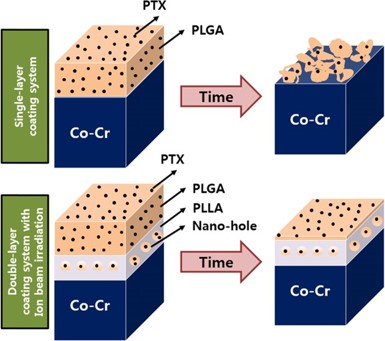Dual-layer Coated Drug-Eluting Stents with Improved Degradation Morphology and Controlled Drug Release
슈퍼관리자
2021-05-21
Dual-layer Coated Drug-Eluting Stents with Improved Degradation Morphology and Controlled Drug Release
-
Authors :
Tarek M. Bedair, Wooram Park, Bang-Ju Park, Myoung-Woon Moon, Kwang-Ryeol Lee, Yoon Ki Joung, Dong Keun Han
-
Journal :
Macromoleular Research
-
Vol :
26
-
Page :
641
-
Year :
2018

Abstract
Drug-eluting stents (DESs) are used to treat cardiovascular diseases such as atherosclerosis. The anti-proliferative drug released from the DES suppress the proliferation of smooth muscle cells and reduced in-stent restenosis. However, a burst release of the drug in the early stages and degradation morphology of the polymer coating represent major disadvantages, which might increase the incidence of in-stent restenosis and/or thrombosis under in vivo clinical studies. To solve these problems, in this study, a double-layer coating system composed of poly(lactide) (PLLA) bottom layer and poly(lactide-co-glycolide) (PLGA) top layer are used for the fabrication of DES. PLLA bottom layer was firstly coated on the metal surface followed by oxygen ion beam treatment. It was found that increasing the ion beam exposure time, increased the roughness of PLLA surface with a nanoscale pocket (or hole)-like structure. The top layer coating represented a mixture of PLGA and paclitaxel (PTX) with 5, 10, and 20% PTX contents. The coating was performed through ultrasonic spray technique, and the morphology showed not only a smooth and uniform surface but also no irregularities were observed at zero day. The drug release and degradation morphology for single-layer (PLGA/PTX) and double-layer (PLLA/PLGA/PTX) coatings were compared. The drug release from the double-layer stainless steel (SS) group showed a slower and controlled drug release for all PTX content samples as compared to single-layer SS group. Moreover, the degradation morphology of double-layer SS group presented a smoother and uniform surface after 12 weeks of degradation under physiological conditions. Therefore, an oxygen ion beam technique with double-layer coating system could effectively control the drug release, i.e., prevent initial burst drug release, and improve the degradation morphology of biodegradable polymer-based DESs.















